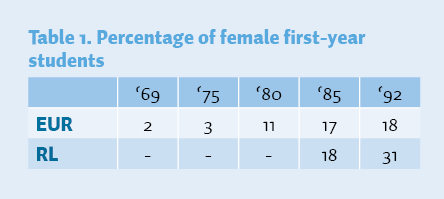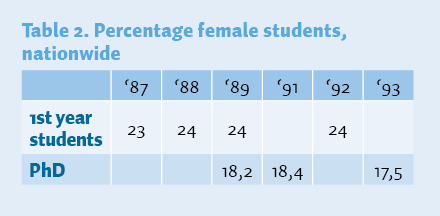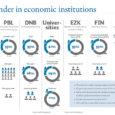Twenty-five years ago, Hein Schreuder and Eline van der Heijden discussed the causes of the low share of women in economics in ESB. We’ve asked them to reflect on what they wrote at the time and on their experiences after that.
In het kort
Women in economics
Why is this article in English?
This article is part of our English publication ‘Women in Economics’. This dossier is in English because English is the main language of the economics and business faculties in the Netherlands, so an ESB dossier about the people who work there should be in English.
Much to my surprise ESB has invited me to reflect on a column I wrote 25 years ago. The column was a condensed version of a presentation I had given at a conference organized by the Emancipation Committee of Maastricht University. The theme was the rising numbers of women among the student population in Economics. Their share had risen from 2–3 percent in the years when I was a student, to 20–30 percent in the early nineties, when I was a professor in Maastricht.

I had chosen a slightly provocative theme and wording, because my aim was to provide a different perspective and to stimulate thought and discussion. My thesis was that this rise in the female share of first-year students would over time translate into similar rises among the scientific staff. Since I had already left academia to join the corporate world before publishing the column, I was very curious to see what the actual developments have been over the last 25 years.
The discussion in 1993
.
Might and ma(i)n
Hein Schreuder. ESB, 78(3913)
In 1985, I predicted that more first-year female economics students (table 1) will lead to more female PhD students, and eventually to more women in all ranks of the economics faculties. Now, in 1993, the rise in the numbers of female PhD students indicates that, so far, my prediction has been correct.
This shift, which has taken place within fifteen years, has two important implications. The first is that female staff appointments in economics will become increasingly normal, eventually leading to more female professors. In economic terms, this is a Vintage model with significant time lags. Second, in recent years, now that men are experiencing that female students are just as successful, the male ‘monoculture’ in economics has been breached. It remains to be seen whether women will take over an increasing share of the higher staff positions at the economics faculties, but so far the trend is encouraging.

Re: Women in economics
Eline van der Heijden. ESB, 78(3918)
I dare not be so optimistic. An important caveat is that, between 1985 and 1993, there even seems to be a small decline in the number of female PhDs (table 2).
A possible explanation might be that economics is still seen as a fairly abstract science, which a number of girls do not regard as the most obvious of choices. In addition, economics does not appear to be exactly female-friendly and the advancement opportunities for women are small. However, Schreuder states that the economists’ world has become less of a man’s world. Overall this may be true, but at certain universities and tracks female students may hardly encounter any female scientific staff, which is an important factor in the desirability of a university on female PhD students. Even when extra effort is exerted, for the time being, women will not be able to establish a foothold in large parts of the economics world.

Postscript
Hein Schreuder. ESB, 78(3918)
Perhaps the most interesting observation is that we – while assuming approximately the same facts about the situation in the economics faculties – arrive at different explanations and evaluations. I believe that one of the causes of this difference in interpretation is the length of time considered. My column deals with the development from the late sixties to the early nineties, while Van der Heijden focuses on the late eighties to the early nineties. A second explanation for our different views, is that we have different experiences at our faculties. Van der Heijden is working in Tilburg, where there is a relatively small number of female PhD’s (9 percent) and scientific staff (3 percent). In Maastricht, within eight years, we’ve arrived at 25 percent of female PhD’s and 8 percent of other scientific staff. As we started out with an exclusively male staff in 1985, the pull effect she describes does not explain this increase. However, the proportion of first-year female students (31 percent) is a lot higher than at other faculties. This may be due to the different profiles of the economics faculties concerned.
As this special issue of ESB illustrates, the news is mixed. Yes, the number and share of women on the economics staff has risen over the years. But no, the share of female scientific staff is not (yet) proportional to the distribution of first-year students. In particular, the number and share of female professors of economics is still disappointingly low. At the same time, recruitment of women into the study of economics remains relatively low as well, both in the Netherlands and in other countries (Mumford, 2014; Fleisher and Schoder, 2017).
These numbers remind me of the situation in the corporate world. Many companies have made a considerable effort over many years in recruiting women and promoting them through the ranks to top positions. Despite the progress that has been made, the results still reflect the situation in the economics profession: female participation rates become lower as staff levels get higher, and for women it is still lonely at the very top.
The usual way in which this situation is debated, is to posit that cultural factors inhibit the applicability of the Vintage model with significant time lags. While such cultural factors undoubtedly play a part, a new perspective has recently emerged, triggered by a number of paradoxical findings with respect to gender equality. For instance, the empirical observation is that in more gender-equal societies less women choose to study science and technology (Stoet and Geary, 2018; The Atlantic, 2018). An even more puzzling finding is that gender differences in most aspects of personality are conspicuously larger in cultures with more egalitarian gender roles, gender socialization and socio-political gender equity (Schmitt et al., 2016; Mac Giolla and Kajonius, 2018). In the Netherlands, which scores relatively high on gender equality in international comparisons, the personality overlap between men and women was 61 percent, while in less gender-equal China this score turned out to be 84 percent. The same counterintuitive pattern has also been found in attachment styles and choice of occupation (Whipple, 2018). In business, Norway is one of the countries leading the way in gender equality in many ways, including a quota law passed a decade ago that prescribes that public companies must have at least 40 percent female non-executive directors. Nonetheless, only 7 percent of public companies are led by a woman, a share that is much lower than in many Asian countries (FT, 2018).
The hypothesis that emerges from these paradoxes is that in wealthier and more gender-equal societies women feel a greater freedom to pursue their own preferences and make their own choices, and there is less pressure to follow the ‘male paths to success’. In economic terms: the revealed preferences of women may increasingly diverge from those of men as gender equality increases. This may not lead to the choices and outcomes we expected. But for my daughter and for my sons, I do hope that they will live in a world which allows them to freely pursue their genuine interests and passions.
References
Fleisher, C. and D. Schoder (2017) The gender gap in economics. American Economic Association, 8 September. Article at www.aeaweb.org.
FT (2018) Enlightened Norway’s gender paradox at the top of business. Financial Times, 20 September.
Mac Giolla, E. and P.J. Kajonius (2018) Sex differences in personality are larger in gender equal countries: replicating and extending a surprising finding. International Journal of Psychology, 11 September. In print. Available at www.ncbi.nlm.nih.gov.
Mumford, K. (2014) More on the gender gap in economics. Royal Economic Society, 1 April. Article at www.res.org.uk.
Schmitt, D., A.E. Long, A. McPhearson et al. (2017) Personality and gender differences in global perspective. International Journal of Psychology, 52(1), 45–56.
Stoet, G. and D.C. Geary (2018) The gender-equality paradox in science, technology, engineering, and mathematics education. Psychological Science, 29(4), 581–593.
The Atlantic (2018) The more gender equality, the fewer women in STEM. The Atlantic, 18 February. Article at www.theatlantic.com.
Whipple, T. (2018) Patriarchy paradox: how equality reinforces stereotypes. The Times, 15 September.
Auteur
Categorieën









